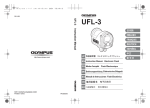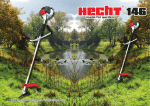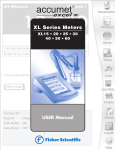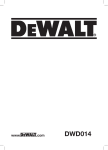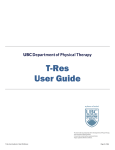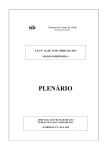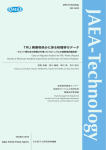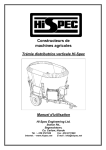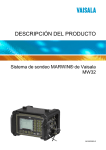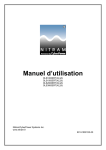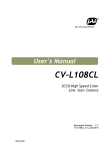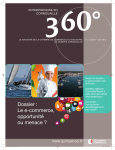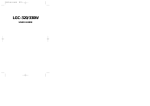Download surgical technique - Tornier BLUEPRINT
Transcript
S H O U L D E R Solutions by Tornier A E Q UA L I S ™ P E R F O R M S U R G I C A L T E C H N I Q U E Aequalis PerFORM G L E N O I D S Y S T E M surgical technique T E C H N I Q U E A E Q UA L I S ™ S U R G I C A L P E R F O R M S U R G I C A L T E C H N I Q U E T O R N I E R table of contents A E Q U A L I S ™ P E R F O R M G L E N O I D S Y S T E M IMPLANT RATIONALE 4 SURGICAL FLOW 5 INDICATIONS/CONTRAINDICATIONS6 SYSTEM COMPATIBILITY 7 COMMON TECHNIQUES FOR THE KEEL, PEG & CORTILOC GLENOIDS 8 • Exposure 8 ARTICULAR CURVATURE OVERVIEW 9 DETERMINING ARTICULAR CURVATURE CANNULATED APPROACH • Optional : BLUEPRINT™ 3D Planning Software • Confirming the Glenoid size • Resurfacing the Glenoid 10 11-16 11 12 13-15 • Drilling the Central Hole 16 STANDARD APPROACH 17-20 • Select the Glenoid Size 17 • Drilling the Central Hole 18 • Resurfacing the Glenoid 19-20 IMPLANTATION OF THE KEELED GLENOID 21-24 • Preparing the Keel Slot 21-22 • Positioning the Keeled Glenoid Component 23-24 IMPLANTATION OF THE TORNIER PEGGED GLENOID 25-26 • Preparing the Peg Holes 25 • Positioning the Pegged Glenoid Component 26 IMPLANTATION OF THE CORTILOC™ PEGGED GLENOID 27-28 • Preparing the Peg Holes 27 • Positioning of the CortiLoc™ Glenoid Component 28 COMPONENTS29-35 • Common Tray - Upper Level 29 • Common Tray - Lower Level 30 • Keeled Tray 31 • Pegged Tray 32 • CortiLoc Tray 33 • Glenoids 34 • Miscellaneous 35 Aequalis™ PerFORM - Surgical Technique - UDTT144 3 implant rationale “With current shoulder arthroplasty systems using a unique glenoid backside radius of curvature, there is a risk to perform excessive reaming to “adapt the bone to the prosthesis” resulting in sacrifice of the subchondral bone. Future implant design should consider including a range of backside radius of curvatures adapted to the arthritic glenoid that may avoid excessive reaming and bone sacrifice by “adapting the prosthesis to the bone.” - DR. GILLES WALCH Glenoid Articular Curvature Comparison Arthritic Glenoids Normal Mean Normal 1 Std Dev Conclusion The average arthritic articular curvature is 39 mm with a range of 10 standard deviation while the average normal articular curvature is 32 mm with a range of 3 standard deviation. Study 1 Study 2 End Point 5 Year 10 Year 15 Year Revision 99.8% 96.0% 77.5% Radiological 99.0% 70.1% 25.8% Revision 99.7% 98.3% N/A Radiological 99.7% 51.5% N/A Study 1: Pattern of Loosening of Polyethylene Keeled Glenoid in Primary OA (A Multi-Centered Study with >5 Year Follow-Up) G. Walch; A. Young; P. Boileau; M. Loew; D. Gazielly; D. Molé Study 2: “Results of a Convex-back Cemented Keeled Glenoid Component in Primary Osteoarthritis: Multicenter Study with Follow-up Greater than 5 Years” G. Walch, A. Young, B. Melis, D. Gazielly, M. Loew, P. Boileau Aequalis™ PerFORM - Surgical Technique - UDTT144 4 surgical flow COMMON PREPARATION SURGICAL FLOW Cannulated Technique Place Pin Position Reamer Ream Drill Non-Cannulated Technique Size Drill Ream ANCHORAGE SPECIFIC SURGICAL FLOW Keel Drill Per.Pegs Punch Trial Pegged Drill Per.Pegs Trial CortiLoc™ Drill Enlarging Hole Aequalis™ PerFORM - Surgical Technique - UDTT144 Drill Per.Pegs 5 Trial indications & contraindications AEQUALIS™ PerFORM GLENOID OVERVIEW The Aequalis™ PerFORM glenoid system is a comprehensive offering that includes a variety of anchorage options such as a Keeled, Standard Pegged and CortiLoc™ Pegged. These designs are based on extensive anatomic studies* and are offered in 4 sizes. Additionally, both common and anchorage specific instrumentation are included in the Aequalis PerFORM glenoid system. The Tornier shoulder prostheses are intended for replacement of the shoulder joint to reduce pain and improve shoulder mobility in comparison with preoperative status. INDICATIONS Prosthetic replacement with this device (Aequalis PerFORM glenoid component + humeral component) may be indicated to relieve severe pain or significant disability caused by: • Degenerative pathologies: osteoarthritis, rheumatoid polyarthritis, post-traumatic arthritis • Primary and secondary necrosis of the humeral head • Displaced 4-part upper humeral fracture • Humeral head fracture • Other pathologies where arthrodesis or resectional arthroplasty of the humeral head are not acceptable • Revisions when other treatments or devices have failed The Aequalis PerFORM glenoids are for use with cemented applications and are labeled as such. CONTRAINDICATIONS • Systemic infection • Fever and/or local inflammation • Rapid joint destruction or bone resorption apparent on roentgenograms • Elevation of sedimentation rate unexplained by other disease, elevation of WBC count • D istant foci of infection from genitourinary, pulmonary, skin and other sites, dental focus infection that may cause haematogenous spread to the implant site • Use of this implant is contraindicated in the presence of significant injury to the upper brachial plexus • Poor quality and/or insufficient quantity of glenoid bone stock (pre- or intraoperative glenoid fracture…) • Nonfunctional deltoid or external rotator muscles • Important and non-reparable rupture of the rotator cuff • Neuromuscular disease (e.g. joint neuropathy) • Known allergy to one of the materials • Patient pregnancy *Tornier internal data on file Aequalis™ PerFORM - Surgical Technique - UDTT144 6 system compatibility The Aequalis™ PerFORM glenoid has been designed to be compatible with the Simpliciti,™ Aequalis,™ and Ascend™ humeral head systems in certain combinations. For more information on the cleared combinations refer to the mismatch charts listed below. (All models are not cleared in all countries; please contact your Tornier representative for information about the availability.) Aequalis™ Ascend Flex Shoulder System Aequalis PerFORM Glenoids (Keeled, Pegged, and CortiLoc™) with Aequalis/Simpliciti and Aequalis™ Ascend Flex Heads - Mismatch Chart Combinations Heads/Glenoids Diametrical Mismatch in mm Size Glenoid Heads 37x13.5 39x14 41x15 43x16 46x17 48x18 50x16 50x19 52x19 52x23 54x23 54x27 Diameter of curvature 39 41.2 43 45 48 50 55 52 54.6 52.4 54.7 54 Small 55.4 16.4 14.2 12.4 10.4 7.4 5.4 0.4 3.4 0.8 3 0.7 1.4 Medium 59.6 20.6 18.4 16.6 14.6 11.6 9.6 4.6 7.6 5 7.2 4.9 5.6 Large 63.6 24.6 22.4 20.6 18.6 15.6 13.6 8.6 11.6 9 11.2 8.9 9.6 XL 67.8 28.8 26.6 24.8 22.8 19.8 17.8 12.8 15.8 13.2 15.4 13.1 13.8 Cleared Mismatches The cleared range for this combination is 1 to 24.8 mm PREOPERATIVE PLANNING A careful analysis of X-rays and axial CT scan views is recommended before surgery to evaluate the following parameters: osteophytes, articular curvature, anterior and, more importantly, posterior wear of the glenoid, as well as the location, orientation and depth of the glenoid vault. Aequalis™ PerFORM - Surgical Technique - UDTT144 7 common techniques COMMON OPERATIVE TECHNIQUES FOR THE KEELED, PEGGED & CORTILOC™ GLENOIDS Exposure With the arm abducted and internally rotated, a posterior glenoid retractor is placed on the posterior glenoid border as the proximal humerus is dislocated posteriorly and inferiorly. An angled retractor placed above the glenoid and an angled Kolbel retractor placed in the subscapular fossa are used to complete the exposure. (Figure 1) If preoperatively the humerus rests in a fixed posteriorly subluxed position, then the posterior capsule may be stretched out sufficiently so that a posterior capsular release for exposure may not be necessary. Figure 1 If, after releasing the entire anterior capsule down to 6 o’clock on the glenoid face the shoulder is still tight, then additional capsule is released around the posterior inferior corner and up the posterior side until the humerus can be adequately retracted for exposure (labrum and posterior capsule). (Figure 1) The glenoid retractor then is moved upward if more of the posterior release needs to be completed. (Figure 2) Figure 2 Aequalis™ PerFORM - Surgical Technique - UDTT144 8 surgical technique ARTICULAR CURVATURE OVERVIEW Recent studies have than that of normal articular curvature as articular curvature is demonstrated that the articular curvature of arthritic glenoids is much different glenoids. In particular, one recent study reported the average arthritic glenoid 40 mm with a range of 11 standard deviations, while the average normal glenoid 32 mm with a range of 3 standard deviations. (Internal data on file) The Aequalis™ PerFORM glenoid system is the first system to incorporate these new finding by offering multiple backside curvatures of each size glenoid to preserve as much cortical bone as possible. The chart below demonstrates the multiple backside curvatures for each of the four glenoid sizes. Backside Radius Small Medium 30 S 30 M 30 35 S 35 M 35 40 S 40 M 40 Large Extra Large L 40 XL 40 50 L 50 XL 50 60 L 60 XL 60 COLOR CODING To improve operative efficiency, the Aequalis PerFORM instrumentation has been color coded by size. Please refer to the chart below to see which colors are associated with which colors. Small Medium Aequalis™ PerFORM - Surgical Technique - UDTT144 Large X-Large 9 surgical technique DETERMINING ARTICULAR CURVATURE Five radius gauges are provided to assist in determining the general size and curvatures of the glenoid. Each radius gauge is marked with the size (S-M / L-XL) and S/I the radius (R30, R35, R40, R50, R60). (Figure 3) The large end of the sizer is used to measure the best fit of the glenoid superiorly/inferiorly, while the smaller opposite end of the sizer is used to measure the best fit of the glenoid anteriorly/posteriorly. A/P Figure 3 To determine the curvature of the glenoid, place a radius gauge against the center of the glenoid. Select the gauge that most precisely fits the native glenoid. This radius will be a determining factor in which instruments are used in subsequent steps. Evaluate the fit of the radius gauge to the face of the glenoid in multiple planes keeping the gauge centered in the glenoid at all times. (Figure 4-5) Ideal Fit Figure 4 Poor Fit Figure 5 Aequalis™ PerFORM - Surgical Technique - UDTT144 10 optional : BLUEPRINT™ 3D Planning Software 3 D P L A N N I N G S O F T W A R E If pre-operative planning is desired, the BLUEPRINT™ Planning Software may be used prior to the procedure to visualize the anatomy in 3-dimensional space (automated 3D reconstruction) and perform a virtual implantation of the Aequalis™ PerFORM glenoid. The software allows the surgeon to virtually position the various implants and understand the optimal path of treatment based on the patient’s anatomy. The software creates a visual aid when making important treatment decisions, including: • Identification of glenoid wear patterns • Visualization of humeral head subluxation & migration • Planning correction of glenoid version • Ensuring full implant seating • Analyzing bone removal required for various implant options (reaming max) • Assuring implant containment within the glenoid vault (size & radius curvature) The BLUEPRINT™ Planning Software also provides information about the patient’s glenoid as well as the virtual implant, including: • Glenoid & Implant Version • Glenoid & Implant Inclination • Scapula Planes (Scapular plane, Transversal scapular plane and glenoid fossa plane) • Glenoid bone removal measurements • Implant seating coverage For complete details on BLUEPRINTTM 3D Planning Software, please refer to the user manual and visit the website www.tornierblueprint.com Aequalis™ PerFORM - Surgical Technique - UDTT144 11 cannulated approach CONFIRMING THE GLENOID SIZE The glenoid size and curvature can be confirmed with the sizer. This is done by applying pressure to the sizer and evaluating the contact area between the bone and sizer. The sizer that has the best match will determine the size and the curvature. (Figure 6) When using the cannulated approach, three pin guides are available that can be attached to the sizer via the rectangular shaped groove. This allows for easy manipulation of the sizer on the face of the glenoid. (Figure 7) Additionally, the guides are cannulated in 0°, 5° and 10° to allow for version correction based upon preoperative planning. It is important to note that the pin guides can place in either the anterior or posterior direction due to the rectangular shape. This allows for the sizer to be placed on the native surface or within the worn defect of the glenoid when placing the guide pin. Figure 6 0˚ 5˚ 10˚ Figure 7 With the appropriate sizer and pin guide assembled, center the sizer on the glenoid and advance the guide pin until bi-cortical fixation is achieved. Then slide the assembly off the guide pin to prepare for reaming. (Figure 8-9) Figure 8 NOTE: If the cannulated pin bends or appears to be bent in any step of the procedure, it must be removed and replaced by a new pin. Figure 9 Aequalis™ PerFORM - Surgical Technique - UDTT144 12 cannulated approach RESURFACING THE GLENOID If the exposure is sufficient to place the reamer down the pin without interference, select the reamer that corresponds with the size and curvature determined in previous steps and attach it to the cannulated reamer driver. If exposure is difficult, a special slot in the internal ring of the reamer will allow the reamer to easily be slided down the pin and past the humerus before the handle is attached to the reamer. (Figure 10) Figure 10 To begin, identify which section of the reamer includes the slot and then place this section over the guide pin. This will allow the reamer to be easily maneuvered past the humerus and retractors. Once the reamer has been introduced into the joint space, slide the central portion of the reamer onto the pin. (Figure 11) Figure 11 Next, place the cannulated reamer driver over the pin. Align the flats on the tip of the driver with those on the reamer and apply pressure to attach the driver to the reamer. (Figure 12) NOTE: It is recommended to irrigate with saline solution while reaming and drilling to prevent heat buildup which can lead to necrosis of the surrounding bone. Figure 12 Aequalis™ PerFORM - Surgical Technique - UDTT144 13 cannulated approach RESURFACING THE GLENOID (Continued) Always begin by hand reaming and advance to power reaming only if necessary. If power is used, engage the reamer prior to contacting the glenoid surface and apply light pressure. This will help to reduce the risk of fracture. (Figure 13) The goal of reaming is to obtain a bony surface that matches the backside of the glenoid component while removing as little bone as possible. The fit between the glenoid component and the bony surface can be evaluated utilizing the sizer from previous steps. It is not advisable to ream down to cancellous bone. Overaggressive reaming should be avoided to prevent possible glenoid fracture and the future risk of component shift or subsidence. Figure 13 Once reaming is complete, remove the assembly by sliding it off the pin. (Figure 14) Figure 14 Aequalis™ PerFORM - Surgical Technique - UDTT144 14 cannulated approach RESURFACING THE GLENOID (Continued) It is also possible to detach the reamer from the driver using the quick release handle. To do so, place the tip of the quick release handle onto the shaft of the driver and slide it down until it sits on the reamer. Apply downward pressure with the handle while pulling up on the driver to detach the reamer. (Figure 15) Remove the individual parts in the reverse order that they were assembled. NOTE: If the cannulated pin bends or appears to be bent in any step of the procedure, it must be removed and replaced by a new pin. Figure 15 Aequalis™ PerFORM - Surgical Technique - UDTT144 15 cannulated approach DRILLING THE CENTRAL HOLE Two drill bit lengths are available, one for the S/M and one for the L/XL size glenoid. To drill the central hole, select the appropriate length (S/M or L/XL) 6 mm cannulated central drill bit and attach it to the drill/reamer driver. Place the assembly over the pin and drill until the collar of the bit is flush with the glenoid. (Figure 16) Figure 16 Remove the assembly over the guide pin and then remove the guide pin before proceeding to the next step. (Figure 17) Figure 17 Aequalis™ PerFORM - Surgical Technique - UDTT144 16 standard approach SELECT THE GLENOID SIZE To select the glenoid size, select the sizer that best matches the peripheral rim of the glenoid. Attach the sizer to the clamp via the small holes in the sizer (Figure 18). Place the sizer onto the glenoid and select the sizer that best matches the peripheral rim of the glenoid. The central location can then be marked through the sizer. Figure 18 The transparent sizers can also be utilized to confirm the curvature of the glenoid. This is done by applying pressure to the sizer and evaluating the contact area between the bone and sizer (Figure 19). The sizer that has the best match will confirm the curvature. Figure 19 Aequalis™ PerFORM - Surgical Technique - UDTT144 17 standard approach DRILLING THE CENTRAL HOLE When using the standard approach, begin by attaching the drill guide handle to the central hole drill guide. Then select the appropriate length (S/M or L/XL) 6 mm central hole drill bit and attach it to the drill/reamer driver via the quick connect mechanism. Figure 20 Once the instruments are assembled, align the guide with central mark that was made when using the sizer (Figure 20) and drill the central hole until the drill bit collar bottoms out on the drill guide. (The drill bit is provided with a laser etch line which represents the depth to be drilled for those who prefer not to use the drill guide.) (Figure 21) Figure 21 Aequalis™ PerFORM - Surgical Technique - UDTT144 18 standard approach RESURFACING THE GLENOID If resurfacing of the glenoid is necessary, select the reamer that corresponds with the size and curvature determined in previous steps. Attach the reamer to either the drill/reamer driver or the articulated driver. Using the Articulated Driver 1. Attach the reamer in the pivoted unlocked position. (Figure 22) Figure 23 2.Once attached, insert the tip of the reamer into the central hole of the glenoid. (Figure 23) 3.Once the reamer tip is seated, use the handle as a lever and retract the reamer shaft into the straight position. Slide the outer sleeve into the locked position. (Figure 24-25) Figure 24 Figure 22 NOTE: It is recommended to irrigate with saline solution while reaming and drilling to prevent heat buildup which can lead to necrosis of the surrounding bone. Figure 25 Aequalis™ PerFORM - Surgical Technique - UDTT144 19 standard approach Always begin by hand reaming and advance to power reaming only if necessary. If power is used, engage the reamer prior to contacting the glenoid surface and apply light pressure. This will help to reduce the risk of fracture. The goal of reaming is to obtain a bony surface that matches the backside of the glenoid component while removing as little bone as possible. The fit between the glenoid component and the bony surface can be evaluated utilizing the sizer from previous steps. It is not advisable to ream down to cancellous bone. Overaggressive reaming should be avoided to prevent possible glenoid fracture and the future risk of component shift on subsidence. CAUTION: The articulated driver can only be used in the straight locked position. NOTE: It may be helpful to remove any posterior retractors prior to inserting the articulated driver. The handle will then in essence become the retractor. Aequalis™ PerFORM - Surgical Technique - UDTT144 20 keeled glenoid IMPLANTATION OF THE AEQUALIS PERFORM KEELED GLENOID Preparing the Keel Slot To prepare the keel slot, begin by selecting the appropriate size (S/M or L/XL) keeled peripheral drill guide. Attach the drill guide to the drill guide handle and insert the post on the backside of the guide into the central hole. (Figure 26) Align the superior and inferior holes with the supero-inferior axis of the native glenoid. (Figure 26) Figure 26 With the drill guide in place, select a drill bit, either the 5 mm drill bit for the S/M size or the 6 mm drill bit for the L/XL and attach the bit to the drill/reamer driver. Drill the superior hole until the collar of the drill bit contacts the guide. (Figure 27) Figure 27 Using the stabilization peg clamp, place the appropriate size stabilization peg into the superior hole and then drill the inferior hole. (Figure 28) Figure 28 Aequalis™ PerFORM - Surgical Technique - UDTT144 21 keeled glenoid The stabilization peg can then be removed along with the guide. (Figure 28-29) The bony bridges between the three holes are broken with a rongeur or small osteotome. Figure 29 Then select the appropriate sized keel punch (S-M or L-XL) which is used to compact the cancellous bone (Figure 30-31). The shape of the keel is then prepared by compacting the cancellous bone using the selected keel punch. Compaction of the cancellous bone is a preferred technique to improve glenoid component fixation. Figure 30 Figure 31 Aequalis™ PerFORM - Surgical Technique - UDTT144 22 keeled glenoid POSITIONING THE KEELED GLENOID COMPONENT Once the keel slot has been fully prepared, select the appropriate size trial glenoid. The trial is inserted into the keel slot using the trial grasper and can be seated with the impactor. (Figure 32) Figure 32 Two windows, anterior and posterior, allow visualization of the bone to trial interface. If the trial has acceptable backside support, remove the trial with the grasper. (Figure 33) Figure 33 Aequalis™ PerFORM - Surgical Technique - UDTT144 23 keeled glenoid It is recommended to carefully clean and dry the glenoid surface and keel slot prior to cementing. Once the glenoid is clean and dry, introduce the bone cement and impact the final implant (Figure 34-36). It is recommended to maintain pressure on the face of the glenoid with the impactor while the cement hardens. It is not recommended to cement the back face of the glenoid. The cement mantle, at the face, should be less than 1 mm.* Figure 34 NOTE: The keel should not be altered in any manner prior to implantation. NOTE: Once a specific anchorage size (S/M or L/XL) has been prepared, it is not advisable to upsize or downsize the implant. Figure 35 Figure 36 *Long-term results of cancellous compaction technique for glenoid replacement in total shoulder arthroplasty for primary osteoarthritis. O. Verborgt, G. Walch, V. Belloti, and D. Gazielly. Aequalis™ PerFORM - Surgical Technique - UDTT144 24 pegged glenoid IMPLANTATION OF THE AEQUALIS PERFORM PEGGED GLENOID Preparing the Peg Holes To prepare the peripheral holes, begin by selecting the S/M or L/XL pegged peripheral drill guide. Attach the drill guide to the drill guide handle and insert the post on the backside of the guide into the central hole. (Figure 37) Figure 37 Align the drill guide on the glenoid. With the drill guide in place, attach the peripheral drill bit to the drill/reamer driver. Drill the superior hole until the collar of the drill bit contacts the guide. (Figure 38) Figure 38 Using the stabilization peg clamp, place the stabilization peg into the superior hole and then drill the anterior hole (Figure 39-40). A second stabilization peg can be inserted for addition stability and the posterior hole is then drilled. (Figure 40) Figure 39 The stabilization pegs can then be removed along with the guide. Figure 40 Aequalis™ PerFORM - Surgical Technique - UDTT144 25 pegged glenoid POSITIONING THE PEGGED GLENOID COMPONENT Once the peripheral holes have been fully prepared, select the appropriate size trial glenoid. The trial is inserted into the glenoid using the trial grasper and can be seated with the impactor. (Figure 41) Figure 41 Two windows, anterior and posterior, allow visualization of the bone to trial interface (Figure 42). If the trial has acceptable backside support, remove the trial with the grasper. Figure 42 It is recommended to carefully clean and dry the glenoid surface and peg holes prior to cementing. Once the glenoid is clean and dry, introduce the bone cement and impact the final implant. It is not recommended to cement the back face of the glenoid. (Figure 43-44) It is recommended to maintain pressure on the face of the glenoid with the impactor while the cement hardens.* Figure 43 NOTE: The pegs should not be altered in any manner prior to implantation. NOTE: Once a specific anchorage size (S/M or L/XL) has been prepared, it is not advisable to upsize or downsize the implant. *Long-term results of cancellous compaction technique for glenoid replacement in total shoulder arthroplasty for primary osteoarthritis. O. Verborgt, G. Walch, V. Belloti, and D. Gazielly. Figure 44 Aequalis™ PerFORM - Surgical Technique - UDTT144 26 cortiloc™ glenoid IMPLANTATION OF THE AEQUALIS PERFORM CORTILOC™ GLENOID Preparing the Peg Holes If not completed in a previous step, the central hole should be enlarged at this time. To enlarge the hole, attach the appropriate length (S/M or L/XL) 8.4 mm CortiLoc drill bit to the drill/reamer driver. Then assemble the CortiLoc central drill guide to the drill guide handle. Place the drill guide on the reamed glenoid. Drill until the collar of the bit contacts the guide. (Figure 45) (The drill bit is provided with a laser etch line which represents the depth to be drilled for those who prefer not to use the drill guide.) Figure 45 Once completed, remove the drill guide and prepare the peripheral holes. To prepare the peripheral holes, begin by selecting one of the S/M or L/XL CortiLoc drill guides. Attach the drill guide to the drill guide handle and insert the tip post on the backside of the guide into the central hole. Figure 46 Align the drill guide on the glenoid. With the drill guide in place, attach the peripheral drill bit to the drill/reamer driver. Drill the superior hole until the collar of the drill bit contacts the guide. (Figure 46) Using the stabilization peg clamp, place the stabilization peg into the superior hole and then drill the anterior hole. (Figure 47) A second stabilization peg can be inserted for additional stability and the posterior hole is then drilled. The stabilization pegs can then be removed along with the guide. Figure 47 Aequalis™ PerFORM - Surgical Technique - UDTT144 27 cortiloc™ glenoid POSITIONING THE CORTILOC™ GLENOID COMPONENT Once the peripheral holes have been fully prepared, select the appropriate size trial glenoid. The trial is inserted into the glenoid using the trial grasper and can be seated with the impactor. (Figure 48) Two windows, anterior and posterior, allow visualization of the bone to trial interface. (Figure 49) If the trial has acceptable backside support, remove the trial with the grasper. Figure 48 It is recommended to carefully clean and dry the glenoid surface and peg holes prior to cementing. Once the glenoid is clean and dry, introduce the bone cement and impact the final implant. It is not recommended to cement the back of the glenoid. (Figure 50) It is recommended to maintain pressure on the face of the glenoid with the impactor while the cement hardens.* Figure 49 The final implant can then be inserted with the trial grasper and seated using the impactor. It is recommended to maintain pressure on the face of the glenoid with the impactor while the cement hardens. NOTE: The pegs should not be altered in any manner prior to implantation. NOTE: Once a specific anchorage size (S/M or L/XL) has been prepared, it is not advisable to upsize or downsize the implant. Reduction Testing and Closure The reduction of the joint, testing of mobility and stability and closure is described in detail in the humeral surgical technique. *Long-term results of cancellous compaction technique for glenoid replacement in total shoulder arthroplasty for primary osteoarthritis. O. Verborgt, G. Walch, V. Belloti, and D. Gazielly. Aequalis™ PerFORM - Surgical Technique - UDTT144 28 Figure 50 components Common Tray - Upper Level (Ref. YKAD210) Reference Description MWE011 MWE012 MWE013 MWE014 MWE015 MWE016 MWE017 MWE018 MWE019 MWE020 MWE021 MWE022 MWE031 MWE032 MWE033 MWE034 MWE035 MWE036 MWE040 MWE111 MWE112 MWE113 MWE042 MWB253 S30 Sizer S35 Sizer S40 Sizer M30 Sizer M35 Sizer M40 Sizer L40 Sizer L50 Sizer L60 Sizer XL40 Sizer XL50 Sizer XL60 Sizer Radius Gauge – Small/Medium 30 mm Radius Gauge – Small/Medium 35 mm Radius Gauge – Small/Medium 40 mm Radius Gauge – Large/Extra Large 40 mm Radius Gauge – Large/Extra Large 50 mm Radius Gauge – Large/Extra Large 60 mm Central Hole Drill Guide – Ø 6 mm Pin Guide 0° Pin Guide 5° Pin Guide 10° Drill Guide Handle Pin Driver Aequalis™ PerFORM - Surgical Technique - UDTT144 YKAD210A (Circular Reamer) YKAD210B (Crescent Reamer) Reference Description MWE153 Cannulated Central Hole Drill Bit – Ø 6 mm Small/Medium Central Holed Drill Bit – Ø 6 mm Small/Medium Cannulated Central Hole Drill Bit – Ø 6 mm Large/Extra Large MWE154 MWE155 Central Holed Drill Bit – Ø 6 mm Large/Extra Large MWE156 Circular Crescent MWE160 MWE161 MWE162 MWE163 MWE164 MWE165 MWE166 MWE167 MWE168 MWE169 MWE170 MWE171 MWE110 MWE260 MWE261 MWE262 MWE263 MWE264 MWE265 MWE266 MWE267 MWE268 MWE269 MWE270 MWE271 -- 29 S30 Reamer S35 Reamer S40 Reamer M30 Reamer M35 Reamer M40 Reamer L40 Reamer L50 Reamer L60 Reamer XL40 Reamer XL50 Reamer XL60 Reamer Sizer Clamp components Common Tray - Lower Level (Ref. YKAD210) Reference Description MWE044 MWE046 MWD552 MWE150 MWE151 MWE152 MWE080 or MWE180* MWB236 MWE114 MWA652 MWE157 Stabilization Peg Remover Glenoid Impactor 12 mm Wrench Articulated Driver Cannulated Reamer Driver Cannulated Drill/Reamer Driver w/Tip T-Handle – SZH Cleaning Rod Glenoid Grasper Trial Grasper Alignment Pin MWE158 Quick Release Handle * Available upon request Aequalis™ PerFORM - Surgical Technique - UDTT144 30 components Keeled Tray (Ref. YKAD213) Reference Description MWE095 MWE096 MWE097 MWE098 MWE199 MWE201 MWE101 MWE102 MWE501 MWE502 MWE503 MWE511 MWE512 MWE513 MWE521 MWE522 MWE523 MWE531 MWE532 MWE533 Keeled Peripheral Drill Guide - Small/Medium Keeled Peripheral Drill Guide - Large/Extra Large Stabilization Peg - Ø 5 mm Stabilization Peg - Ø 6 mm Peripheral Drill Bit - Ø 5 mm Peripheral Drill Bit - Ø 6 mm Keeled Punch - Small/Medium Keeled Punch - Large/Extra Large S30 Keeled Glenoid Trial S35 Keeled Glenoid Trial S40 Keeled Glenoid Trial M30 Keeled Glenoid Trial M35 Keeled Glenoid Trial M40 Keeled Glenoid Trial L40 Keeled Glenoid Trial L50 Keeled Glenoid Trial L60 Keeled Glenoid Trial XL40 Keeled Glenoid Trial XL50 Keeled Glenoid Trial XL60 Keeled Glenoid Trial Aequalis™ PerFORM - Surgical Technique - UDTT144 31 components Pegged Tray (Ref. YKAD212) Reference Description MWE090 MWE091 MWE083 MWE200 MWE301 MWE302 MWE303 MWE311 MWE312 MWE313 MWE321 MWE322 MWE323 MWE331 MWE332 MWE333 Pegged Peripheral Drill Guide - Small/Medium Pegged Peripheral Drill Guide - Large/Extra Large Stabilization Peg - Ø 5.4 mm Peripheral Drill Bit Dia - Ø 5.4 mm S30 Pegged Glenoid Trial S35 Pegged Glenoid Trial S40 Pegged Glenoid Trial M30 Pegged Glenoid Trial M35 Pegged Glenoid Trial M40 Pegged Glenoid Trial L40 Pegged Glenoid Trial L50 Pegged Glenoid Trial L60 Pegged Glenoid Trial XL40 Pegged Glenoid Trial XL50 Pegged Glenoid Trial XL60 Pegged Glenoid Trial Aequalis™ PerFORM - Surgical Technique - UDTT144 32 components CortiLoc™ Pegged Tray (Ref. YKAD211) Reference Description MWE081 MWE082 MWE083 MWE200 MWE085 CortiLoc Peripheral Drill Guide - Small/Medium CortiLoc Peripheral Drill Guide - Large/Extra Large Stabilization Peg - Ø 5.4 mm Peripheral Drill Bit Dia - Ø 5.4 mm CortiLoc Central Drill Guide CortiLoc Cannulated Central Drill Bit - Small/Medium CortiLoc Cannulated Central Drill Bit - Large/Extra Large CortiLoc Central Drill Bit - Small/Medium CortiLoc Central Drill Bit - Large/Extra Large S30 CortiLoc Pegged Glenoid Trial S35 CortiLoc Pegged Glenoid Trial S40 CortiLoc Pegged Glenoid Trial M30 CortiLoc Pegged Glenoid Trial M35 CortiLoc Pegged Glenoid Trial M40 CortiLoc Pegged Glenoid Trial L40 CortiLoc Pegged Glenoid Trial L50 CortiLoc Pegged Glenoid Trial L60 CortiLoc Pegged Glenoid Trial XL40 CortiLoc Pegged Glenoid Trial XL50 CortiLoc Pegged Glenoid Trial XL60 CortiLoc Pegged Glenoid Trial MWE202 MWE203 MWE204 MWE205 MWE401 MWE402 MWE403 MWE411 MWE412 MWE413 MWE421 MWE422 MWE423 MWE431 MWE432 MWE433 Aequalis™ PerFORM - Surgical Technique - UDTT144 33 components Keeled Glenoid Reference Description DWE501 DWE502 DWE503 S30 Keeled Glenoid S35 Keeled Glenoid S40 Keeled Glenoid DWE511 DWE512 DWE513 M30 Keeled Glenoid M35 Keeled Glenoid M40 Keeled Glenoid DWE521 DWE522 DWE523 L40 Keeled Glenoid L50 Keeled Glenoid L60 Keeled Glenoid DWE531 DWE532 DWE533 XL40 Keeled Glenoid XL 50 Keeled Glenoid XL 60 Keeled Glenoid Pegged Glenoid Reference Description DWE301 DWE302 DWE303 S30 Pegged Glenoid S35 Pegged Glenoid S40 Pegged Glenoid DWE311 DWE312 DWE313 M30 Pegged Glenoid M35 Pegged Glenoid M40 Pegged Glenoid DWE321 DWE322 DWE323 L40 Pegged Glenoid L50 Pegged Glenoid L60 Pegged Glenoid DWE331 DWE332 DWE333 XL40 Pegged Glenoid XL 50 Pegged Glenoid XL 60 Pegged Glenoid CortiLoc™ Pegged Glenoid Reference Description DWE401 DWE402 DWE403 S30 CortiLoc Glenoid S35 CortiLoc Glenoid S40 CortiLoc Glenoid DWE411 DWE412 DWE413 M30 CortiLoc Glenoid M35 CortiLoc Glenoid M40 CortiLoc Glenoid DWE421 DWE422 DWE423 DWE431 DWE432 DWE433 L40 CortiLoc Glenoid L50 CortiLoc Glenoid L60 CortiLoc Glenoid XL40 CortiLoc Glenoid XL 50 CortiLoc Glenoid XL 60 CortiLoc Glenoid Aequalis™ PerFORM - Surgical Technique - UDTT144 34 components Miscellaneous Order Information Reference Description DWD014 DWD013 DWD015 DWD011 DWD012 DWD013 MWE157 (1) DWD063 (2) MWB319 (2) DWD168 (1) Pressurization Kit Peg Glenoid Cement Scraper Peg Nozzle Pressurization Kit Keeled Glenoid Keel Nozzle Cement Scraper Non-Sterile Pin – Ø 2.5 X 200 mm Sterile Single Use Pin – Ø 2.5 X 200 mm Non-Sterile Pin – Ø 2.5 X 200 mm Aequalis™ PerFORM - Surgical Technique - UDTT144 Sterile Single Use Pin – Ø 2.5 X 200 mm 35 notes Aequalis™ PerFORM - Surgical Technique - UDTT144 36 notes Aequalis™ PerFORM - Surgical Technique - UDTT144 37 notes Aequalis™ PerFORM - Surgical Technique - UDTT144 38 notes Aequalis™ PerFORM - Surgical Technique - UDTT144 39 U S H E A D Q UA R T E R S I N T E R N AT I O N A L H E A D Q UA R T E R S M A N U FA C T U R E R Tornier, Inc. 10801 Nesbitt Avenue South Bloomington, MN 55437 USA + 1 952 426 7600 Tornier SAS 161 rue Lavoisier 38330 Montbonnot Saint Martin France + 33 (0)4 76 61 35 00 www.tornier.com Manufacturer BLUEPRINT™ 3D Planning Software: IMASCAP SAS, 65 Place Copernic, 29280 PLOUZANE, FRANCE Distributor BLUEPRINT™ 3D Planning Software: Tornier SAS, FRANCE Prior to using any Tornier device, please review the instructions for use and surgical technique for a complete listing of indications, contraindications, warnings, precautions, potential adverse events, and directions for use. Aequalis™ PerFORM - Surgical Technique - UDTT144








































